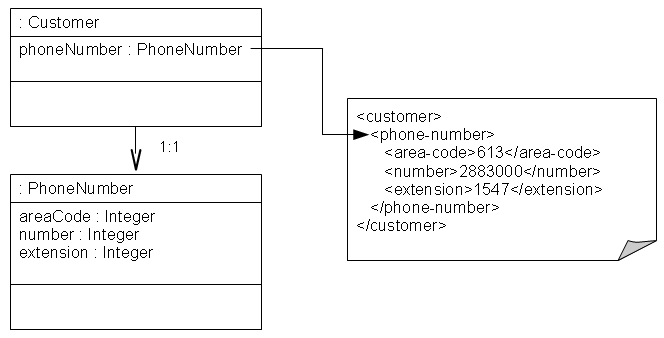Notice: this Wiki will be going read only early in 2024 and edits will no longer be possible. Please see: https://gitlab.eclipse.org/eclipsefdn/helpdesk/-/wikis/Wiki-shutdown-plan for the plan.
EclipseLink/UserGuide/MOXy/Relationships/Privately Owned/One-to-One
EclipseLink MOXy
| EclipseLink | |
| Website | |
| Download | |
| Community | |
| Mailing List • Forums • IRC • mattermost | |
| Issues | |
| Open • Help Wanted • Bug Day | |
| Contribute | |
| Browse Source |
Contents
Mapping One-to-One Relationships
This section demonstrates several ways to map a one-to-one relationship between objects.
Mapping to a Complex Type
Given the XML schema in this example, the figure below illustrates a one-to-one relationship between two complex types.
<?xml version="1.0" encoding="UTF-8"?> <xsd:schema xmlns:xsd="http://www.w3.org/2001/XMLSchema"> <xsd:element name="customer" type="customer-type"/> <xsd:complexType name="customer-type"> <xsd:element name="address" type="address-type"/> </xsd:complexType> <xsd:complexType name="phone-type"> <xsd:element name="area-code" type="xsd:int"/> <xsd:element name="number" type="xsd:int"/> <xsd:element name="extension" type="xsd:int"/> </xsd:complexType> </xsd:schema>
The following example shows how to annotate your Java class to obtain this mapping with EclipseLink. All that is needed is the standard JAXB @XmlElement annotation.
@XmlRootElement public class Customer { @XmlElement(name="phone-number") public PhoneNumber phoneNumber; } public class PhoneNumber { @XmlElement(name="area-code") public Integer areaCode; @XmlElement public Integer number; @XmlElement public Integer extension; }
The example below shows how to to define your mapping information in EclipseLink's OXM metadata format.
... <java-type name="Customer"> <xml-root-element name="customer"/> <java-attributes> <xml-element java-attribute="phoneNumber" name="phone-number" type="PhoneNumber"/> </java-attributes> </java-type> <java-type name="PhoneNumber"> <java-attributes> <xml-value java-attribute="areaCode" name="area-code" type="java.lang.Integer"/> <xml-value java-attribute="number" type="java.lang.Integer"/> <xml-value java-attribute="extension" type="java.lang.Integer"/> </java-attributes> </java-type> ...
"Self" Mappings
EclipseLink allows you to configure your one-to-one mapping such that the data from the target object will appear inside the source object's XML element. This is referred to as a "self" mapping, and is achieved by setting the target object's XPath to ".". The following example demonstrates a self mapping declared in annotations.
@XmlRootElement public class Customer { @XmlElement(name="phone-number") @XmlPath(".") public PhoneNumber phoneNumber; } public class PhoneNumber { ... }
The example below shows a self mapping defined on EclipseLink OXM metadata format.
... <java-type name="Customer"> <xml-root-element name="customer"/> <java-attributes> <xml-element java-attribute="phoneNumber" name="phone-number" type="PhoneNumber"/> </java-attributes> </java-type> <java-type name="PhoneNumber"> ... </java-type> ...
Using a self mapping, the following XML will be produced:
<customer> <area-code>613</area-code> <number>2883000</number> <extension>1547</extension> </customer>

